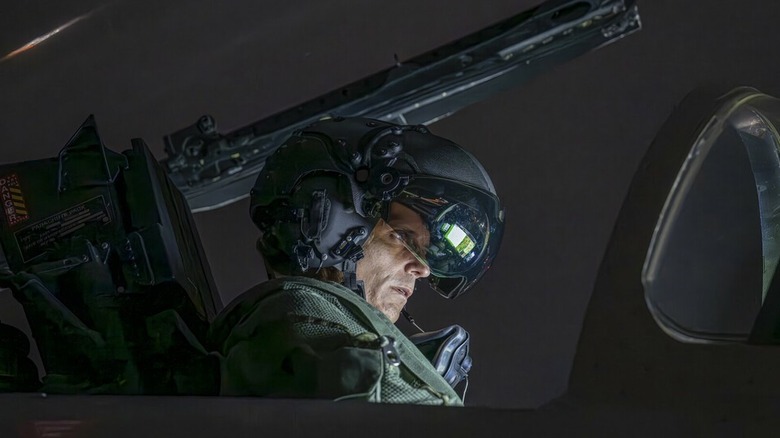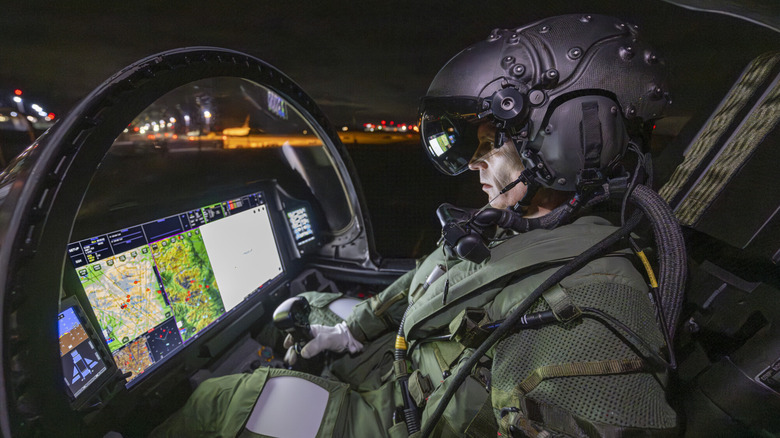Why Do Typhoon Fighter Pilot Helmets Have Bumps On Them?
Technology has played a dominant role in rewriting the rules of warfare. Today, a military's might is increasingly influenced not so much by its size, but rather by the sophistication and effectiveness of the tools at its disposal. One of such tools is the Striker HMSS (Helmet Mounted Symbology System) helmet, developed by BAE Systems and used by fighter pilots who operate the Eurofighter Typhoon.
The Eurofighter Typhoon is one of the most advanced combat aircraft today, and it makes sense that its pilots are equipped with the best possible equipment to maximize the aircraft's capabilities. Immediately recognizable by the numerous "bumps" on its surface, the Striker helmet is unlike any flight helmet, and may just be the most effective weapon of war available to the pilot once behind the controls of the multi-million dollar aircraft.
Those "bumps" are a network of infrared LEDs that track the position and angle of the pilot's head in real time. As the head turns, the LEDs flash and are detected by sensors in the cockpit, allowing the system to accurately determine where the pilot is looking. This head-tracking data is then processed and projected as critical information directly onto the pilot's visor.
It is an ingenious system that allows the pilot to immediately track, identify, and engage multiple targets using voice commands without having to turn the aircraft in the direction of the threat.
Utilizing the Striker's advanced helmet technology in battle
In April 2024, Iran launched a swarm of 170 drones and 30 cruise missiles towards Israel in what marked a dramatic escalation of the long-standing conflict between the two nations. UK RAF Typhoon FGR4 jets were part of the aerial coalition involved in engaging the threats as they crossed the night sky toward Israel.
Pilots flying the Typhoon FGR4, wearing their Striker HMDs (Helmet-Mounted Display), would have found this to be exactly the kind of situation where those specialized helmets were designed to perform best. Of course, the UK Typhoon jets were not alone — they were joined in the sky by other military aircraft from the U.S., Israel, and Jordan.
However, the Typhoon pilots would have still found themselves with a multitude of targets to engage at any point in time. The Striker helmets with their advanced capabilities would have allowed the pilots to keep track and acquire crucial targeting information on several drones and missiles at the same time. Cameras all around the aircraft are also linked to the Striker helmet, allowing the pilot to "see" through the shell of the aircraft, engaging targets that would normally be beyond his vision range.
The Striker helmet represents a significant evolution from early combat flight helmets, which were primarily designed to protect the pilot's head.
The Striker helmet upgrade is on the way
In this age of advanced warfare and cutting-edge military technology, helmets like the Striker HMD will be the principal way to interface pilots with their weapons systems. According to the Express, Mark Bowman — BAE Systems Test Pilot and Director of Flight Operations — said the Striker helmet represents "a major advance in terms of combat capability and is something that gives Typhoon pilots a significant advantage when it comes to air combat."
The original Striker helmet, first introduced in 2009, had about a $400,100 per unit cost. Pilots received individually tailored Striker helmets, created using precise head scans of the pilot for an optimal fit. The helmets were rolled out to pilots in the U.K., Italy, Germany, and Spain — all countries that jointly developed the Eurofighter Typhoon.
In December 2024, BAE Systems was awarded the sum of 133 million pounds (approximately $178 million) by the consortium of countries behind the Eurofighter Typhoon. This is to accelerate the development of Striker II, an upgraded version of the existing helmets. The Striker II helmet is touted by BAE Systems as the world's only helmet-mounted display which combines a 40-degree field of view, daylight-readable color display, and built-in night vision. All development and integration work on the Striker II helmet is expected to be finished by 2027, with procurement commencing soon after.



